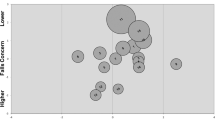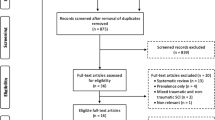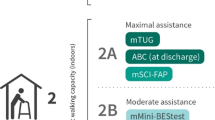Abstract
Study design
Cross-sectional study.
Objectives
To evaluate the reliability and calculate the measurement error of the Trunk Assessment Scale for Spinal Cord Injury (TASS) and trunk control test (TCT-SCI) in individuals with spinal cord injury (SCI).
Setting
Rehabilitation Hospital in Japan.
Methods
The evaluations of TASS and TCT-SCI for individuals with SCI were video-recorded. The inter-rater reliability (two physiotherapists) was confirmed using the videos. ICC (2,1), kappa coefficient (κ) were used to determine the reliability of the total score and each item. Each minimal detectable change (MDC) was calculated.
Results
The TASS and TCT-SCI total scores showed excellent inter-rater reliability (ICC = 0.99, and 1.00). The kappa coefficients of TASS were acceptable to excellent for 8 items (κ = 0.76–1.00), below acceptable for 1 item (κ = 0.62). The kappa coefficients of TCT-SCI were excellent for 12 items (κ = 0.83–1.00), below acceptable for 1 item (κ = 0.68). The inter-rater MDC of the TASS total score was 4.07 points, and the MDC of the TCT-SCI total score was 1.13 points. The intra-rater MDC of the TASS total score was 3.86 points.
Conclusion
Both TASS and TCT-SCI showed high reliability. Differences of less than four points in TASS and one point in TCT-SCI were interpreted as measurement errors between the two raters.
Similar content being viewed by others
Log in or create a free account to read this content
Gain free access to this article, as well as selected content from this journal and more on nature.com
or
Data availability
The datasets generated and analyzed during the current study are available from the corresponding author on reasonable request.
References
ASIA and ISCoS International Standards Committee. The 2019 revision of the International Standards for Neurological Classification of Spinal Cord Injury (ISNCSCI)-What’s new? Spinal Cord. 2019;57:815–7.
Kirshblum S, Snider B, Rupp R, Read MS. International Standards Committee of ASIA and ISCoS. Updates of the International Standards for Neurologic Classification of Spinal Cord Injury: 2015 and 2019. Phys Med Rehabil Clin N Am. 2020;31:319–30.
Roberts TT, Leonard GR, Cepela DJ. Classifications in brief: American Spinal Injury Association (ASIA) impairment scale. Clin Orthop Relat Res. 2017;475:1499–504.
Jones ML, Harness E, Denison P, Tefertiller C, Evans N, Larson CA, et al. Activity-based therapies in spinal cord injury: clinical focus and empirical evidence in three independent programs. Top Spinal Cord Inj Rehabil. 2012;18:34–42.
Milosevic M, Yokoyama H, Grangeon M, Masani K, Popovic MR, Nakazawa K, et al. Muscle synergies reveal impaired trunk muscle coordination strategies in individuals with thoracic spinal cord injury. J Electromyogr Kinesiol. 2017;36:40–8.
Quinzanos J, Villa AR, Flores AA, Perez R. Proposal and validation of a clinical trunk control test in individuals with spinal cord injury. Spinal Cord. 2014;52:449–54.
Quinzanos-Fresnedo J, Fratini-Escobar PC, Almaguer-Benavides KM, Aguirre-Guemez AV, Barrera-Ortiz A, Perez-Zavala R, et al. Prognostic validity of a clinical trunk control test for independence and walking in individuals with spinal cord injury. J Spinal Cord Med. 2020;43:331–8.
Boswell-Ruys CL, Sturnieks DL, Harvey LA, Sherrington C, Middleton JW, Lord SR, et al. Validity and reliability of assessment tools for measuring unsupported sitting in people with a spinal cord injury. Arch Phys Med Rehabil. 2009;90:1571–7.
Field-Fote EC, Ray SS. Seated reach distance and trunk excursion accurately reflect dynamic postural control in individuals with motor-incomplete spinal cord injury. Spinal Cord. 2010;48:745–9.
Jorgensen V, Elfving B, Opheim A. Assessment of unsupported sitting in patients with spinal cord injury. Spinal Cord. 2011;49:838–43.
Lynch SM, Leahy P, Barker SP. Reliability of measurements obtained with a modified functional reach test in subjects with spinal cord injury. Phys Ther. 1998;78:128–33.
Sprigle S, Maurer C, Holowka M. Development of valid and reliable measures of postural stability. J Spinal Cord Med. 2007;30:40–9.
Wadhwa G, Aikat R. Development, validity and reliability of the ‘Sitting Balance Measure’ (SBM) in spinal cord injury. Spinal Cord. 2016;54:319–23.
Abou L, de Freitas GR, Palandi J, Ilha J. Clinical instruments for measuring unsupported sitting balance in subjects with spinal cord injury: a systematic review. Top Spinal Cord Inj Rehabil. 2018;24:177–93.
Bjornshave Noe B, Mikkelsen EM, Hansen RM, Thygesen M, Hagen EM. Incidence of traumatic spinal cord injury in Denmark, 1990-2012: a hospital-based study. Spinal Cord. 2015;53:436–40.
Johansson E, Luoto TM, Vainionpaa A, Kauppila AM, Kallinen M, Vaarala E, et al. Epidemiology of traumatic spinal cord injury in Finland. Spinal Cord. 2021;59:761–8.
McCaughey EJ, Purcell M, McLean AN, Fraser MH, Bewick A, Borotkanics RJ, et al. Changing demographics of spinal cord injury over a 20-year period: a longitudinal population-based study in Scotland. Spinal Cord. 2016;54:270–6.
Nijendijk JH, Post MW, van Asbeck FW. Epidemiology of traumatic spinal cord injuries in The Netherlands in 2010. Spinal Cord. 2014;52:258–63.
Sabre L, Pedai G, Rekand T, Asser T, Linnamagi U, Korv J, et al. High incidence of traumatic spinal cord injury in Estonia. Spinal Cord. 2012;50:755–9.
Miyakoshi N, Suda K, Kudo D, Saka H, Nakagawa Y, Mikami Y, et al. A nationwide survey on the incidence and characteristics of traumatic spinal cord injury in Japan in 2018. Spinal Cord. 2021;59:626–34.
Sato H, Yoshikawa K, Miyata K, Sano A, Mizukami M. Development and reliability of Trunk Assessment Scale for Spinal Cord Injury (TASS). Rigakuryohogaku. 2021;48:321–9.
Kottner J, Audige L, Brorson S, Donner A, Gajewski BJ, Hrobjartsson A, et al. Guidelines for Reporting Reliability and Agreement Studies (GRRAS) were proposed. Int J Nurs Stud. 2011;48:661–71.
Terwee CB, Bot SD, de Boer MR, van der Windt DA, Knol DL, Dekker J, et al. Quality criteria were proposed for measurement properties of health status questionnaires. J Clin Epidemiol. 2007;60:34–42.
Terwee CB, Mokkink LB, Knol DL, Ostelo RW, Bouter LM, de Vet HC, et al. Rating the methodological quality in systematic reviews of studies on measurement properties: a scoring system for the COSMIN checklist. Qual Life Res. 2012;21:651–7.
Prinsen CAC, Mokkink LB, Bouter LM, Alonso J, Patrick DL, de Vet HCW, et al. COSMIN guideline for systematic reviews of patient-reported outcome measures. Qual Life Res. 2018;27:1147–57.
Fisher R. Statistical methods for research workers. V ed. Edinburgh, United Kingdom, Oliver and Boyd; 1934.
Streiner D, Norman G, Cairney J. Health measurement scales: a practical guide to their development and use. Oxford, United Kingdom: Oxford University Press; 2015.
Di Carlo S, Bravini E, Vercelli S, Massazza G, Ferriero G. The Mini-BESTest: a review of psychometric properties. Int J Rehabil Res. 2016;39:97–105.
Smidt N, van der Windt DA, Assendelft WJ, Mourits AJ, Deville WL, de Winter AF, et al. Interobserver reproducibility of the assessment of severity of complaints, grip strength, and pressure pain threshold in patients with lateral epicondylitis. Arch Phys Med Rehabil. 2002;83:1145–50.
Bland JM, Altman DG. Statistical methods for assessing agreement between two methods of clinical measurement. Lancet. 1986;i:307–10.
Bland JM, Altman DG. Agreement between methods of measurement with multiple observations per individual. J Biopharmaceutical Stat. 2007;17:571–82.
Giavarina D. Understanding Bland Altman analysis. Biochem Med. 2015;25:141–51.
R Core Team. R: a language and environment for statistical computing. Version 3.6.3[software]. 2020. https://www.R-project.org/.
Acknowledgements
We would like to thank Editage (www.editage.com) for English language editing.
Author information
Authors and Affiliations
Contributions
All authors were involved in conceptualizing the research. HS and SK collect the data. HS performed the data analysis with interpretation provided by all authors. HS wrote the initial draft, all authors were involved in editing, producing, and approving the final manuscript. MM got funding.
Corresponding author
Ethics declarations
Competing interests
The authors declare no competing interests.
Ethical approval
We certify that all applicable institutional and governmental regulations concerning the ethical use of human volunteers were followed during the course of this research.
Additional information
Publisher’s note Springer Nature remains neutral with regard to jurisdictional claims in published maps and institutional affiliations.
Rights and permissions
About this article
Cite this article
Sato, H., Miyata, K., Yoshikawa, K. et al. Reliability and minimal detectable change of the Trunk Assessment Scale for Spinal Cord Injury (TASS) and the trunk control test for individuals with spinal cord injury. Spinal Cord Ser Cases 8, 30 (2022). https://doi.org/10.1038/s41394-022-00502-0
Received:
Revised:
Accepted:
Published:
DOI: https://doi.org/10.1038/s41394-022-00502-0



